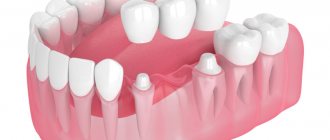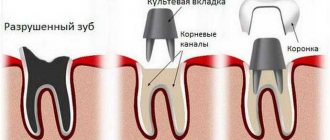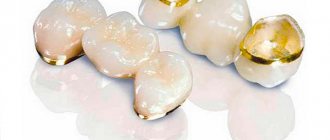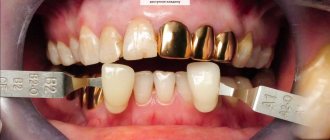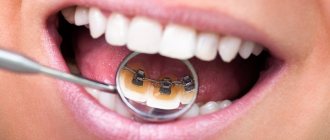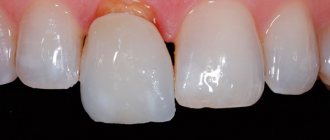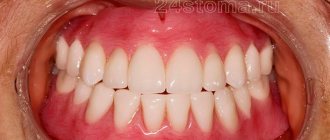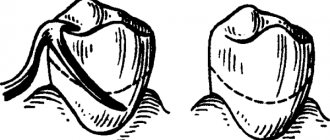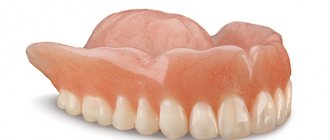Crowns are one of the types of dentures that can be used to restore lost or severely damaged teeth. Crowns are used in classical prosthetics and are placed on implant abutments after dental implantation.
Crowns are always selected taking into account a number of factors, and the area of the tooth that needs to be restored is always taken into account. What should crowns be like for chewing teeth? Let's look at this important issue together.
What is a metal crown?
A crown is a microprosthesis that covers the entire surface or a separate part of a destroyed tooth in order to restore its anatomical integrity.
Externally, the manufactured structure resembles a cap used when the tooth structure is destroyed by more than 50%, and a conventional filling is not able to correct this situation. If the segment is completely destroyed, the prosthesis is fixed using adjacent teeth or special implants are used.
Crown installation is a restoration method in which a pre-prepared prosthesis is placed on the remaining tooth (like a cap). Today, in addition to functionality, prosthetics can also solve any aesthetic problems, because modern designs are identical in appearance to natural teeth.
Video on the topic:
Which tooth crown is better: metal or metal-ceramic?
The fundamental difference between these types is the material of the frame shell and the method of installing the microprosthesis. A metal-ceramic prosthesis is made from a cast metal frame, which is repeatedly coated with ceramic mass and fired at a certain temperature in an oven. In the process of installing a crown, the finished frame is first tried on the tooth and adjusted, and then the ceramic shell of the crown is created. The metal-ceramic prosthesis is completely identical to a living tooth, which allows its installation in the smile area.
A little bit of my advertising and let's continue:
I, Sergey Samsakov, an orthopedic dentist with more than
10 years of successful experience
, propose to restore the beauty of the dentition quickly and safely only with metal ceramics or ceramics based on zirconium dioxide or e-max. I highly recommend Cerec technology, which allows you to restore a problematic tooth with a metal-free crown in literally 1-1.5 hours. I do not use pure metal in my work, as I care about the aesthetics of the patient’s dentition.
Indications for installation
Prosthetics are prescribed by the attending physician in cases where:
- you need to straighten a crooked tooth or change its size/shape/shade;
- fluorosis was detected;
- the inflammatory process damaged more than half of the coronal part of the tooth, and the pulp was removed;
- there is a need to restore a damaged or lost tooth;
- Due to the incorrect location and size of the teeth, dental anomalies are observed. Contraindications include:
- advanced stages of periodontal disease;
- allergic intolerance to the material used;
- malocclusion;
- thinned tooth walls;
- low location of the coronal part of the segment.
Requirements for the stump
For proper fixation, the doctor must adhere to the following rules:
- prevent overhanging edges and ledges, eliminate the presence of the equator;
- the axis of the tooth and the surface of the stump must be strictly parallel;
- grind the tooth in the range from 0.25 to 0.3 millimeters, maintaining the natural shape of the dental organ.
By following the listed rules, the specialist minimizes the possibility of problems arising when using prosthetics with metal products.
Types of dental crowns
In orthopedic practice, well-known metal crowns are still popular. Despite the fact that a wide variety of innovative methods of prosthetics have appeared, metal structures do not lose their positions due to their affordable price and impressive service life.
Sputtered gold crowns were the very first to appear, after which durable steel prostheses began to be actively used.
Depending on the manufacturing method , metal crowns are divided into three groups:
- Stamped. Standard products that require pre-processing with a special machine to give the desired shape. Installation is possible only if at least a third of the tooth crown remains intact.
- Solid cast. Crowns that are created based on the patient’s individual impression. The precision casting method is used, as a result of which it is possible to reproduce the desired anatomical shape of the tooth.
- Combined. These can be either cast or stamped products, the surface of which is lined with plastic or porcelain.
Stamped
Solid cast
Combined
Metal-ceramic crowns: can they be called the best for prosthetics of chewing teeth?
In some materials on the Internet you can see that metal ceramics are advertised as the best material for crowns of chewing teeth. Is it really? Let's try to figure this issue out together, but first we will briefly tell you what metal-ceramic crowns are.
A metal-ceramic crown has a metal base, which is covered with layers of ceramic mass on top. The metal frame ensures the strength of the crown, the ceramic coating provides aesthetics, and some doctors seriously recommend them to their patients as the best option for installation on chewing teeth. In fact, this is not the case; metal-ceramic crowns cannot be called the best for restoring chewing teeth for a number of reasons.
What materials are they made from?
Most people, especially older people, are accustomed to associating the word “crown” with a gold tooth, but modern medicine has advanced so much that the prosthetic products used are practically no different from real teeth.
Reference! The main difference between such designs is the material, the type of which will determine the service life and external aesthetics of the manufactured crown.
Metal
Despite the fact that metal crowns are still used, in the modern world such structures should long ago become a relic of bygone days. Even such significant advantages as high wear resistance and incredible strength do not cover their one, but impressive drawback - an extremely unaesthetic appearance.
In addition, it is quite difficult to place a metal crown on a damaged tooth segment. And finding a clinic that uses such outdated restoration methods is not so easy.
There are two main types of metal crowns:
- from alloys of precious metals : prostheses made from the most popular precious metal - gold. There are also silver structures, but in terms of their characteristics they are significantly inferior to gold prostheses, so at present they are almost never installed;
- from alloys of base metals : crowns made of titanium, which do not have a long service life, but at the same time boast an affordable price.
Gold crowns
Titanium crowns
Metal ceramics
A distinctive feature of such designs is the use of a ceramic coating, which in its appearance resembles real enamel. Metal-ceramic crowns are durable, and their cost is relatively low, so among all the proposed options, these prostheses are the most optimal in terms of price and quality ratio.
There is also a significant drawback: the lack of translucency of the coating when fixed to the front teeth reveals the artificiality of the design. After installation, a gap remains between the gum and the crown, in which the metal base of the product is visible. Because of this, an unaesthetic dark stripe is formed.
There are two varieties :
- on alloys of precious metals : made on the basis of the metal we have already discussed - gold. They differ from ordinary metal products in a more advantageous appearance, but at the same time they are just as wear-resistant and hypoallergenic;
- on alloys of non-precious metals : an alternative to expensive gold products are models made from an alloy of nickel, cobalt and chromium. This material is highly durable, however, over time, the gums under the prosthesis become very dark, and some people may even develop allergic intolerance.
Gold-based metal ceramics
Combined
Metal-plastic
A special plastic overlay is attached to the metal base of the prosthesis, which imitates the structure of tooth enamel.
Such crowns quickly lose their original appearance, change shade and do not have high strength. However, the affordable price and the possibility of rapid production make it possible to use such products as temporary prosthetics.
Pros and cons of crowns
It is impossible to call the installation of crowns a uniquely positive procedure. It has a number of contraindications and disadvantages. But there are much more advantages from it, so it has not lost its relevance for decades.
Advantages
There are significantly more positive aspects of crown prosthetics than negative ones. The advantages of the procedure include:
- maintaining the health of the tooth when it is partially destroyed;
- restoration of chewing function of the jaws;
- protection against tooth decay with removed pulp;
- restoration of intelligible and clear speech;
- possibility of crown replacement;
- restoration of the aesthetic appearance of the smile.
A large number of advantages outweigh some of the disadvantages of the procedure. But they are still worth considering before deciding to install.
Flaws
Like any medical procedure, crown placement is not without its drawbacks. Its disadvantages:
- significant grinding of healthy tooth tissue;
- the procedure is not performed if the root is damaged;
- limited crown service life;
- the need for regular monitoring by a doctor.
Despite the number of shortcomings, dental crowns remain popular and in demand. This is an effective way to restore the integrity of your smile and jaw function without significant financial investment.
Manufacturing of solid crowns
The latest technological developments in the field of prosthetic dentistry have allowed us to reach a higher level thanks to the development of cast metal prostheses. Unlike stamped crowns, solid-cast products fit as closely as possible to the teeth, thereby achieving the exact anatomical shape of the destroyed segment.
The production of a cast structure occurs in several stages :
- The dentist conducts a preliminary examination of the oral cavity, studies the patient’s medical record, after which preparation and further taking of all necessary impressions are performed to recreate the anatomical structure of the tooth.
- Next, based on the impressions obtained, specialists make a plaster test model of the crown and model the future product using special wax.
- At the next clinical stage, the patient’s tooth surface undergoes additional grinding. This procedure is necessary to ensure that the created prosthesis fits most tightly to the surface of the tooth. A wax-filled crown is placed on the damaged segment, after which all excess wax is removed through a pre-drilled channel. The orthopedist eliminates all inaccuracies, and the finished sample is sent back to the laboratory for further production of a solid metal structure.
Find out more about the production of solid crowns:
Stamped
Since a stamped crown is a budget type of prosthetics, and the technologies used are not highly accurate, the resulting impression will not be identical to the shape of a natural tooth.
A stamped prosthesis is created as follows :
- To make a model, as in the production of a cast prosthesis, at the initial stage the tooth surface is prepared to give it the desired shape.
- Then impressions are made of two jaws: the one where the crown will be installed, and the opposite one with antagonist teeth. Based on two casts, a plaster model is made, which is later installed in a special occluder.
- At the next stage, wax modeling of the crown is performed, after which they begin to make a plaster stamp. Based on the created plaster model, the subsequent creation of a metal stamp will be carried out.
- At the end of the process, a suitable blank sleeve is selected and the final stamping of the product is done.
How stamped crowns are made:
Preparing a tooth for a crown
The successful outcome of a dentist’s work largely depends on preliminary preparation for prosthetics.
If necessary, depulpation is carried out and the root canals are filled. If the carious process has led to further tissue destruction, a mandatory stage of prosthetics is performed - preparation. To do this, hard layers of dental tissue are removed and the segment is ground to the desired shape. Preparation is performed using several methods:
- Ultrasonic turning. The doctor uses special ultrasonic tips with replaceable attachments. This method perfectly levels the tooth surface without leaving any cracks or chips.
- Laser preparation. This type of turning is based on the use of an erbium crystal, which processes tissue using laser irradiation.
- Tunnel grinding method. It is based on the use of turbine units, which, in turn, contributes to excessive heating of tooth enamel. A fairly radical method of treatment, in which it is difficult to avoid painful damage to the gums.
- Air abrasive method. Grinding of the tooth surface occurs due to the impact of an air flow mixed with special powders.
- Chemical preparation. A swab soaked in lactic acid is applied to the desired segment, after which the treated tissue is easily ground down using dental instruments.
Taking an impression to make a crown:
Possible complications
Depends on how the crown is placed on the tooth. If all indications and contraindications for prosthetics are observed, the correct choice of dental material, prosthetic technique, and high-quality performance of all work, complications, as a rule, do not occur or are reduced to a minimum. Sometimes the cause of complications is the individual characteristics of the patient’s body.
Pain under the crown
After treatment and prosthetics, moderate pain may persist for some time (1–5 days), decreasing in intensity. But if the tooth under the crown hurts, and the pain does not decrease, but increases, tissue swelling appears, pus is released from the gums or the temperature rises, you should immediately consult a doctor - this is a sign of an inflammatory process. The cause of inflammation may be incompletely cured caries or incompletely removed pulp from the root canals. Another reason is violations during the installation of the prosthesis, its loose fit to the remains of the natural crown and infection getting under it.
Pain under the prosthesis with irradiation into the jaw also occurs when the root canal is perforated with a pin or when a small part of the instrument used to clean the root canal is broken off. What to do: you should not try to treat a bad tooth on your own; this requires urgent help from a dentist. Usually the crown is removed, the pathological process is treated, and then the crown is reinstalled (new or old, if it is not destroyed). Sometimes pathology can be eliminated without removing the crown, simply by drilling a hole in it. The hole is then repaired using photo-curing filling materials.
If the toothache under the crown is very severe, before seeking medical help, you can take a painkiller: Paracetamol 500 mg tablet, Ketorol 10 mg or Naise 100 mg.
Unpleasant smell
Indicates the presence of an infection in the mouth. This may be a slow inflammatory process, or it may be an acute one, in which case the tooth also hurts. The cause of an unpleasant odor from a tooth under a crown can also be insufficient oral hygiene, smoking and eating a lot of sweets. What to do: consult a doctor; this symptom can only be eliminated in the dentist’s office.
Allergy
Allergic reactions are most often associated with the installation of crowns made of non-precious alloys of metal and plastic (acrylic). Redness and swelling of the gums and pain appear. The allergic process is dangerous because it can quickly spread to surrounding tissues. At the same time, the tissues of the larynx swell, breathing is impaired (Quincke's edema). What to do: contact your dentist immediately. Help consists of replacing the prosthesis that has caused an allergy to a structure made of a different material. At home, the patient can take a tablet of any antihistamine: Zodak, Claritin, Tavegil, etc.
Caries
The cause of the development of dental caries under the crown is most often incompletely cured primary caries. But sometimes, even after careful treatment, caries develops again (secondary caries). This happens especially often when the crown does not fit tightly (an infection gets under it), poor oral hygiene, or consumption of large amounts of easily digestible carbohydrates. What to do: Contact your dentist as soon as possible. The product is removed, caries is treated, and then the structure is reinstalled. If it is worn out, install a new one.
Prosthetic stomatitis
The appearance of painful ulcers on the gums in the area of prosthetics and their spread to the oral mucosa largely depends on how the crown is placed on the tooth. Prosthetic stomatitis is a consequence of improper design or installation of a crown, squeezing small blood vessels of the gums, leading to malnutrition and destruction of the mucous membrane. Sometimes the cause of stomatitis is the toxic effect of dental material (acrylic) on oral tissue. If an infection is added to the inflammation, stomatitis can be purulent. What to do: consult a dentist, find out and eliminate the cause of the complication.
Fitting and installation
Installation of a denture occurs in three stages :
- Fitting. Before final fixation, the doctor must try on the manufactured product. In order for the frame of the metal structure to fit tightly to the stump, any flaws and inaccuracies must be excluded. If mistakes are made and the shape is incorrectly made, the prosthesis is sent for additional processing.
- Installation on temporary cement. If the model is made correctly, the specialist proceeds with the subsequent fixation of the crown. First, temporary cement is used to assess the state of the bite and the reaction of the teeth. If any defects are found, the product can be easily removed without any harm to the tooth.
- Installation on permanent cement. If the patient does not experience any discomfort while wearing a crown with temporary cement, the product is removed and fixed with permanent cement.
Advantages and disadvantages of various types of prosthetics
| Product type | Advantages | Flaws |
| Metal ceramics | Affordable price. Not a bad look. Long service life. | Requires significant grinding of the tooth surface. Undesirable placement on the front teeth due to the presence of a translucent metal base. |
| Metal-plastic | Low price. Fast production. | Outdated manufacturing method. Service life is no more than two years. Under the influence of wine and coffee, the material changes its color. |
| Metal | High wear resistance and durability. The optimum ratio of price and quality. | Due to their unaesthetic appearance, they are not suitable for fixation on the front teeth. Can cause an allergic reaction. |
Watch a video about choosing the type of dental crowns:
Contraindications
Not all patients can have crowns. Contraindications to the procedure:
- the last stage of periodontitis - the prosthesis may fall out due to weakened jaw tissue;
- enamel fragility - due to the risk of tooth decay;
- Bruxism - increased tone of the jaw muscles during stress or sleep;
- small height of the teeth and their incorrect position - the crown will not hold;
- pathological bite with incisal overlap - artificial crowns will wear out and destroy healthy teeth.
For some crown materials there are age restrictions for use. Therefore, only a doctor can choose the right prosthesis during a personal consultation.
Our advantages
At the OUR PEOPLE clinic, they value the health of their patients, so doctors install crowns only when indicated. If this method of prosthetics is not suitable, the dentist will select another correction method. An individual approach and attention to each patient is the key to high quality medical care at the SVOI PEOPLE clinic. Thanks to this, our clients wear dental crowns for many years.
